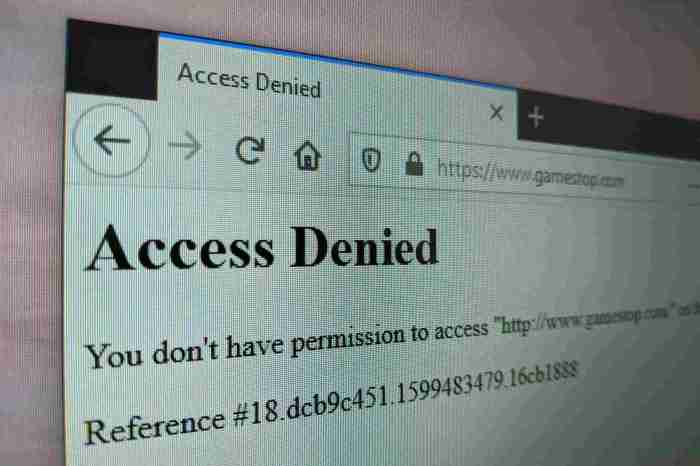Access to this content denied based on report_view acls – In the realm of data access, understanding access control lists (ACLs) is paramount. When it comes to report viewing, ACLs play a pivotal role in determining who can and cannot access sensitive information. This article delves into the concept of report view ACLs, exploring their significance and providing practical guidance on troubleshooting and managing access issues.
ACLs empower administrators to define granular permissions, ensuring that only authorized individuals have access to specific reports. However, when users encounter “access denied” errors, it’s essential to identify and resolve the underlying causes. This article provides a step-by-step approach to diagnosing and addressing access problems, empowering users to regain access to the reports they need.
Access Restrictions Based on Report View ACLs

Access control lists (ACLs) are a fundamental security mechanism used to manage access permissions for various resources, including reports. In the context of report viewing, ACLs define which users or groups are allowed to view specific reports or report data.
ACLs are typically implemented at the data source or reporting platform level, allowing administrators to control access based on user roles, groups, or individual users. By leveraging ACLs, organizations can ensure that only authorized individuals have access to sensitive or confidential information contained in reports.
Examples of ACL-Based Access Restrictions, Access to this content denied based on report_view acls
- Restricting access to financial reports to users with the “Finance Manager” role.
- Granting access to sales reports only to members of the “Sales Team” group.
- Allowing specific users to view reports containing personally identifiable information (PII).
Identifying and Resolving Access Issues
Users may encounter “access denied” errors when attempting to view reports due to various reasons, including:
- Incorrect user permissions or roles.
- Outdated or misconfigured ACLs.
- Technical issues with the reporting platform.
Troubleshooting and Resolving Access Issues
- Verify the user’s permissions and roles to ensure they align with the report’s ACLs.
- Check the ACLs associated with the report to identify any discrepancies or missing permissions.
- Contact the system administrator or IT support to resolve technical issues.
Best Practices for Managing Report Access

To ensure appropriate levels of security and data privacy, organizations should adopt the following best practices for managing report access:
- Regularly review and update ACLs to reflect changes in user roles and responsibilities.
- Use the principle of least privilege, granting only the minimum necessary permissions to users.
- Implement role-based access control (RBAC) to simplify access management and reduce the risk of unauthorized access.
- Monitor user access logs to identify any suspicious or unauthorized activity.
Alternative Methods for Accessing Reports
In cases where direct access to a report is denied due to ACL restrictions, users can explore alternative methods to obtain the necessary information:
- Report Subscriptions:Subscribe to reports to receive them via email or other notification channels.
- Email Notifications:Set up email notifications to receive alerts when specific reports are generated or updated.
- Scheduled Exports:Schedule regular exports of reports to a designated location, such as a shared drive or cloud storage.
Technical Implementation Considerations: Access To This Content Denied Based On Report_view Acls

The technical implementation of report view ACLs involves the use of permissions and roles within the underlying data source or reporting platform. For example, in SQL Server Reporting Services (SSRS), permissions are managed through the role-based security model, where users are assigned to roles that grant specific levels of access to reports and other resources.
Code snippets or examples can be provided to demonstrate how ACLs can be configured and managed in different reporting platforms.
General Inquiries
What are ACLs and how do they relate to report viewing?
ACLs are access control lists that define who can and cannot access specific reports. They allow administrators to set granular permissions, ensuring that only authorized individuals have access to sensitive information.
Why might I encounter an “access denied” error when trying to view a report?
Access denied errors can occur for several reasons, including incorrect ACL settings, insufficient user permissions, or technical issues. This article provides a step-by-step guide to troubleshooting and resolving access issues.
What are some best practices for managing report access?
Best practices include regularly reviewing and updating ACLs to reflect changes in user roles and responsibilities, implementing role-based access control, and using alternative methods for accessing reports when direct access is restricted.